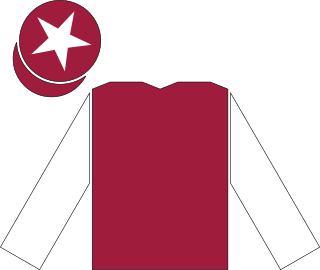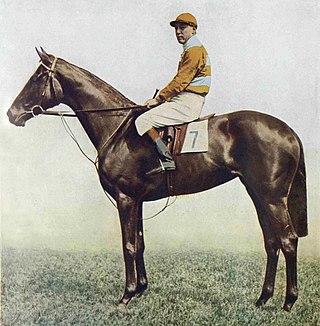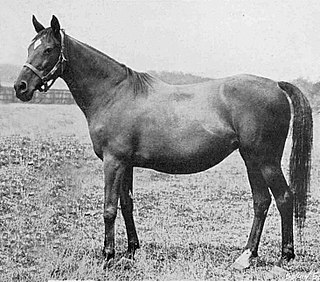Related Research Articles
Mariah's storm is an American thoroughbred racehorse, bred by Donald T. Johnson's Crescent Farm in Lexington, Kentucky. She suffered a serious injury while racing but later made a full recovery and continued her career.
Classy 'n Smart was a Canadian Hall of Fame Thoroughbred racehorse. Bred and raced by Sam-Son Farm, she won five of nine career starts, including two legs of what would later be known as the Canadian Triple Tiara. Although she was voted the 1984 Canadian Champion 3-Year-Old Filly, her primary legacy is as a champion broodmare.
Darshaan was a British-bred, French-trained Thoroughbred racehorse and a Champion sire and broodmare sire.

Time Charter was an Irish-bred, British-trained Thoroughbred racehorse and broodmare who won several major middle-distance races between 1982 and 1984. After winning twice as a two-year-old in 1981, she developed into a classic filly in the following year, finishing second in the 1000 Guineas before winning The Oaks in record time. Later that year she won the Sun Chariot Stakes before beating a field of colts and older horses by seven lengths in the Champion Stakes. As a four-year-old she won England's premier weight-for-age race, the King George VI and Queen Elizabeth Stakes and successfully conceded seven pounds to the outstanding French filly All Along in the Prix Foy. In 1984 she recorded an impressive four length victory in the Coronation Cup and was retired from racing at the end of the year having won nine of her twenty races. She later became a very successful broodmare.

Kazzia was a German-bred Thoroughbred racehorse, who was trained in Germany, the United Arab Emirates and the United Kingdom. In a racing career which lasted from September 2001 until October 2002 she ran seven times and won five races in four different countries. She is best known for successfully completing the Classic double of the 1,000 Guineas and the Oaks. She was the first German-bred horse to win a British Classic. After her retirement from racing she became a successful broodmare. Kazzia died in March 2013 from post-foaling complications.

Dancing Rain is a retired Thoroughbred mare that was bred in Ireland and raced in the United Kingdom, Ireland, Germany and Japan. Dancing Rain was the unanticipated winner of the 2011 Epsom Oaks and won the Preis der Diana in the later part of her three-year-old season. Her form faltered late in her three-year-old year, finishing 16th out of a field of 19 horses in the Queen Elizabeth II Commemorative Cup in Japan. Her four-year-old season was plagued with injury and she did not run in a race until late October 2012. Retired at the end of 2012, Dancing Rain became a broodmare at Clairemont Stud in Hampshire and was subsequently sold to Sheik Mohammed bin Rashid Al Maktoum for £4.2m while in foal to Frankel.

Sun Princess (1980–2001), was an Irish-bred British-trained Thoroughbred racehorse and Broodmare. In a career which lasted from September 1982 until October 1984, she ran ten times and won three races. She recorded all her successes at Group One level when a three-year-old in 1983 winning the Classic Epsom Oaks by a record margin of twelve lengths and the Yorkshire Oaks against other females before defeating colts in the St. Leger Stakes. In the same season she was placed in Europe's two most prestigious all-aged races, finishing third in the King George VI and Queen Elizabeth Stakes and second in the Prix de l'Arc de Triomphe. She raced without winning in 1984 before she was retired to stud, where she became the dam of several winners including the Dewhurst Stakes winner Prince of Dance.
Cantelo was a British Thoroughbred racehorse and broodmare. In a career which lasted from spring 1958 until September 1959 she ran eleven times and won eight races. Cantelo was unbeaten in five races as a two-year-old including the Royal Lodge Stakes, in which she defeated colts. As a three-year-old in 1959 she won the Classic St Leger, as well as the Cheshire Oaks and the Ribblesdale Stakes. Her defeats came when finishing second in The Oaks and the Park Hill Stakes and running fourth to Alcide in the King George VI and Queen Elizabeth Stakes. She was retired from racing after her St Leger win and had some success as a broodmare.
Carrozza is a British Thoroughbred racehorse. In a racing career lasting from May 1956 until July 1957, the filly ran seven times and won three races for her owner Queen Elizabeth II. As a three-year-old she finished fourth in the 1000 Guineas at Newmarket before winning Oaks at Epsom. She was retired to stud after one further race and had some success as a broodmare.

Lupe (1967–1989) was a British Thoroughbred racehorse. In a racing career lasting from September 1969 until July 1971, the filly ran seven times and won six races. As a three-year-old she won the Oaks at Epsom and the Yorkshire Oaks at York before sustaining her only defeat in the Prix Vermeille. Lupe returned as a four-year-old and defeated colts to win the Coronation Cup and the Princess of Wales's Stakes. She was then retired from racing and became a successful broodmare.

Light Shift was an American-bred, British-bred Thoroughbred racehorse and broodmare best known for winning the 2007 Epsom Oaks. In a racing career which lasted from June 2006 to October 2007 the filly ran nine times and won four races. After winning once as a two-year-old, Light Shift won the Cheshire Oaks on her second appearance as a three-year-old. She then won the Classic Oaks over one and a half miles at Epsom, beating the Irish filly Peeping Fawn. Light Shift never won another race, being beaten by Peeping Fawn in the Irish Oaks and the Nassau Stakes and finishing unplaced in the Prix de l'Opéra.

Intrepidity was a British-bred, French-trained Thoroughbred racehorse. In a racing career which lasted from April 1993 to November 1994 the filly ran twelve times and won four races. Unraced as a two-year-old, Intrepidity proved to be the outstanding three-year-old filly in Europe in 1993, winning the Prix Saint-Alary and the Prix Vermeille in France and The Oaks in England. She also finished fourth in the Prix de l'Arc de Triomphe, beaten one and a half lengths. At the end of the year she was voted European Champion Three-year-old Filly at the Cartier Racing Awards. Intrepidity was kept in training as a four-year-old, but failed to win, although she finished second in the Prix Ganay and the Prix Foy. She was then retired to stud where her record as a broodmare was disappointing.

Meteora (1802–1821) was a British Thoroughbred racehorse and broodmare who won the classic Oaks Stakes at Epsom Downs Racecourse in 1805. In a racing career which began with her win in the Oaks on 31 May 1805 and lasted until July 1810 she ran thirty-six timeas and won twenty-four races. She defeated the Derby winner Cardinal Beaufort and the St Leger winner Staveley in match races and won many other important races of the era including the Stamford Gold Cup, the Oatlands Stakes (twice), the Audley End Stakes, the Somerset Stakes and the Brighton Gold Cup. Many of her defeats occurred when she was carrying large weights in handicap races.
Morel was a British Thoroughbred racehorse and broodmare who won the classic Oaks Stakes at Epsom Downs Racecourse in 1808. In a racing career which lasted from April 1808 until July 1812 the mare ran twenty-seven times and won fourteen races. She was mainly campaigned at Newmarket Racecourse, running against some of the best horses of the era in match races and frequently carrying large weights in handicaps. Unlike many champions of the early 19th century, she was particularly effective at shorter distances, recording many of her successes over a mile or less. After her retirement from racing, Morel became a highly successful and influential broodmare, whose direct descendants have won numerous major races in Europe, North America, Japan and Australasia.
Hycilla was a British Thoroughbred racehorse and broodmare, who raced during World War II and was best known for winning the classic Oaks Stakes in 1944. Unraced as a juvenile, she finished second on her three-year-old debut before winning the Oaks, which was run that year at Newmarket Racecourse. She was beaten when favourite for St Leger but ended her year with a win in the Champion Stakes. In the following year, she failed to win but ran well in defeat when third in a strongly-contested Coronation Cup. She retired to become a broodmare in the United States but made little impact, producing four minor stakes winners.
Light Brocade (1931–1947) was a British Thoroughbred racehorse and broodmare. She was one of the best two-year-old fillies in England in 1933 when she won three of her four races including the Molecomb Stakes and Cheveley Park Stakes. In the following year she finished second in the 1000 Guineas before recording her biggest win in the Epsom Oaks. She was beaten in her only subsequent start and retired with a record of four wins from eight starts. She made little immediate success as a broodmare but her female-line descendants went on to have great success in Japan.

Beam was a British Thoroughbred racehorse and broodmare. As a juvenile she showed promise by winning one race and finishing third in the Molecomb Stakes. In the following year she finished fourth in the 1000 Guineas and won the Haverhill Stakes before beating a strong field to take the Epsom Oaks in a race record time which stood for more than half a century. She was retired from racing at the end of the season. Beam made no impact as a dam of winners and died in 1941 at the age of seventeen.

Straitlace was a British Thoroughbred racehorse and broodmare. As a two-year-old she was one of the best fillies of her generation in England when she won five of her eight races. In the following year she finished third in the 1000 Guineas before going on to win the Epsom Oaks, Coronation Stakes and Nassau Stakes, as well as three other races. She earned more money than any other horse in Britain in 1924 and was retired after winning eight of her sister races. Straitlace was exported to France in 1925 and became a very successful and influential broodmare.

La Roche was a British Thoroughbred racehorse and broodmare. As a two-year-old in 1899 she showed some promise, winning once from six attempts, but appeared to be some way below top class. In the following season, when tried over longer distance, she emerged as one of the best horses of her generation in England, winning the Oaks Stakes, Manchester Cup, Yorkshire Oaks and Newmarket Oaks as well as finishing fourth in the 1000 Guineas and third in the Doncaster Cup. She was retired at the end of the season to become a broodmare and had considerable success as a dam of winners.
Brulette was a French-bred Thoroughbred racehorse and broodmare. After winning one minor race as a juvenile she emerged as a top-class middle-distance horse in the following year, winning the Prix Penelope and the Epsom Oaks as well as finishing second in the Prix Vermeille and fourth in the Prix de l'Arc de Triomphe. When campaigned over longer distances in 1932 she won the Prix du Cadran in France before being transferred to England where she won the Goodwood Cup and Jockey Club Cup. After failing to reproduce her best form in 1933 she was retired from racing.
References
- The Complete Encyclopedia of Horse Racing - written by Bill Mooney and George Ennor